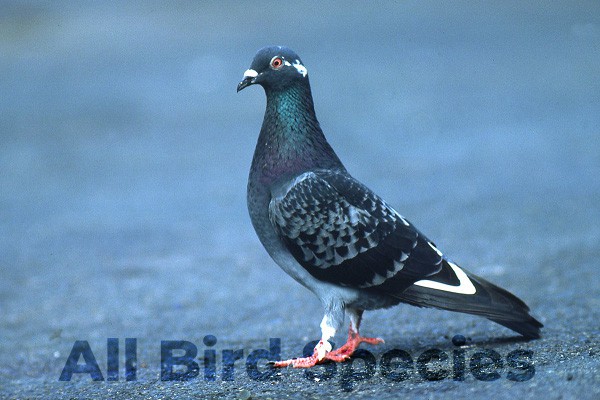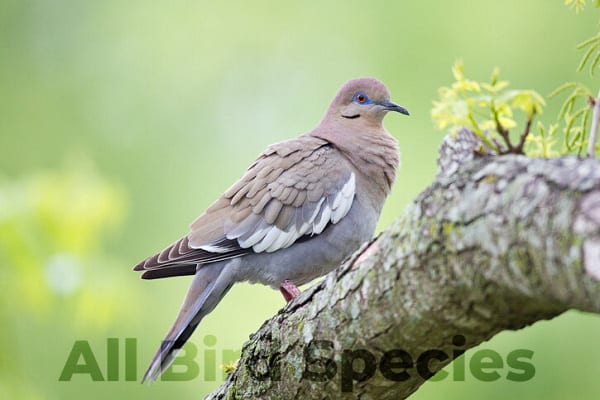4 Types Of Doves in Michigan (ID Guide With Pictures)
In this article, we’ll explore four doves of species that call Michigan home: the common Mourning Dove, the introduced Eurasian collared dove, the familiar Rock Pigeon, and the rare White-winged Dove. We’ll learn about their unique characteristics, where to find them, and why they’re such an important part of Michigan’s diverse ecosystem. So, spread your wings, and let’s dive into the wonderful world of Michigan’s doves!
Common Doves Found in Michigan
- Mourning Dove
- Eurasian Collared-Dove
- Rock Pigeon
- White-winged Dove (Rare)
1. Mourning Dove
- Scientific Name: Zenaida macroura
- Size: 23-34 cm (9-13 inches) long
- Weight: 112-170 grams (4-6 ounces)
- Lifespan: Up to 5 years in the wild, 19 years in captivity
- Diet: Seeds, grains, and occasionally insects
The Mourning Dove is perhaps the most familiar dove species in Michigan. Named for its soft, mournful cooing sound, this bird is a common sight in backyards, parks, and open fields across the state. With its sleek, gray-brown body and long, pointed tail, the Mourning Dove is both beautiful and easily recognizable.

These gentle birds are known for their swift, direct flight and their habit of foraging on the ground for seeds. Mourning Doves are also remarkable parents, with both males and females sharing the duties of building the nest, incubating the eggs, and caring for their young. Their ability to thrive in various habitats, from urban areas to rural farmlands, has made them one of Michigan’s most successful and widespread bird species.
Where to Find This Bird
Mourning Doves are abundant throughout Michigan and can be found in almost every habitat except dense forests. Here are some great places to spot them:
- Backyard bird feeders, especially those offering seeds on the ground
- Open fields and agricultural areas
- Urban parks and gardens
- Along roadsides, often perched on telephone wires
- Kensington Metropark near Milford, which offers diverse habitats
- Sleeping Bear Dunes National Lakeshore, where they can be seen in open areas
Remember, Mourning Doves are most active during early morning and late afternoon, so these are the best times to observe them.
2. Eurasian Collared-Dove
- Scientific Name: Streptopelia decaocto
- Size: 31-33 cm (12-13 inches) long
- Weight: 150-200 grams (5.3-7.1 ounces)
- Lifespan: Up to 10 years in the wild
- Diet: Seeds, grains, and occasionally insects
The Eurasian Collared-Dove is a relative newcomer to Michigan’s bird scene. Originally native to Europe and Asia, these doves have rapidly expanded their range across North America since being introduced to the Bahamas in the 1970s. They’re slightly larger than Mourning Doves, with a pale gray body and a distinctive black half-collar on the back of their neck.

Known for their adaptability, Eurasian Collared-Doves have quickly made themselves at home in Michigan’s urban and suburban areas. They have a distinctive three-noted call that sounds like “kuk-kooooo-kook,” which is quite different from the soft cooing of Mourning Doves. These birds are often seen perched on wires, rooftops, and in trees, and they readily visit bird feeders, especially those offering seeds.
Where to Find This Bird
While not as widespread as Mourning Doves, Eurasian Collared-Doves are becoming increasingly common in Michigan. Here are some places where you might spot them:
- Suburban neighborhoods, especially those with bird feeders
- City parks and gardens
- Agricultural areas and grain storage facilities
- Along the southern and western edges of Michigan, where they first entered the state
- Muskegon State Park, where they’ve been regularly observed
- Holland State Park, another location where they’re frequently seen
Keep in mind that Eurasian Collared-Doves are still expanding their range in Michigan, so you might spot them in new areas each year!
3. Rock Pigeon
- Scientific Name: Columba livia
- Size: 29-37 cm (11-15 inches) long
- Weight: 240-300 grams (8.5-10.6 ounces)
- Lifespan: 3-5 years in the wild, up to 15 years in captivity
- Diet: Seeds, grains, fruits, and occasionally small invertebrates
The Rock Pigeon, often simply called the “pigeon,” is a familiar sight in cities and towns across Michigan. These birds, with their plump bodies and small heads, come in a variety of colors and patterns, from the classic blue-gray to white, brown, and even piebald combinations. Despite their urban reputation, Rock Pigeons are actually quite remarkable birds with a long history of interaction with humans.

Originally native to Europe, North Africa, and western Asia, Rock Pigeons were introduced to North America by early European settlers. They’ve since become well-established in urban environments, where tall buildings mimic the cliff faces of their ancestral habitats. Rock Pigeons are known for their ability to find their way home over long distances, a skill that has been utilized by humans for centuries in the form of homing pigeons.
Where to Find This Bird
Rock Pigeons are abundant in urban and suburban areas across Michigan. Here are some common places to observe them:
- City centers, especially around tall buildings and monuments
- Parks and public squares in towns and cities
- Under bridges and overpasses
- Around grain elevators and agricultural storage facilities
- Detroit’s Hart Plaza, where large flocks often gather
- Michigan State University campus in East Lansing
Remember, while Rock Pigeons are common, it’s important to appreciate their adaptability and the interesting role they’ve played in human history.
4. White-winged Dove (Rare)
- Scientific Name: Zenaida asiatica
- Size: 29-31 cm (11-12 inches) long
- Weight: 150-200 grams (5.3-7.1 ounces)
- Lifespan: Up to 10 years in the wild
- Diet: Seeds, fruits, and occasionally insects
The White-winged Dove is a rare and exciting find for bird enthusiasts in Michigan. Typically found in the southwestern United States and Central America, these doves occasionally wander north, treating Michigan birders to a special sighting. They’re easily distinguished from other doves by the white stripe along the edge of their wings, which is especially visible when they’re in flight.

White-winged Doves are slightly larger than Mourning Doves and have a more rounded tail. They have a distinctive call that sounds like “who cooks for you,” which is quite different from the calls of other doves found in Michigan. While they’re not regular residents of the state, the occasional appearance of a White-winged Dove always causes excitement in the local birding community.
Where to Find This Bird
Since White-winged Doves are rare visitors to Michigan, there aren’t specific locations where you can reliably find them. However, here are some tips for potentially spotting one:
- Keep an eye on bird feeders, especially in late spring and summer when these birds might wander north
- Check eBird reports for recent sightings in Michigan
- Look in areas with fruit-bearing trees or shrubs
- Pay attention to dove flocks – a White-winged Dove might be mixed in with Mourning Doves
- Tawas Point State Park has had occasional sightings during migration periods
- The Whitefish Point Bird Observatory is another potential spot during migration
Remember, seeing a White-winged Dove in Michigan is a rare treat, so always report your sightings to help other birders!
Read More🐦Related Articles:
- Largest Birds of Prey
- Swallow Spiritual meaning
- Blue Colored Birds
- Hummingbirds in Maryland
- Spiritual Meaning Of Ducks
- Can Birds Eat Popcorn?
Summary
Michigan’s dove population offers a fascinating glimpse into the world of these gentle birds. From the common Mourning Dove to the rare White-winged Dove, each species brings its own unique characteristics and behaviors to our state’s diverse ecosystem.
The Mourning Dove, with its soft cooing and graceful flight, is a familiar and beloved sight across Michigan. Found in a variety of habitats from urban backyards to rural fields, these adaptable birds play a crucial role in seed dispersal and provide food for various predators.







